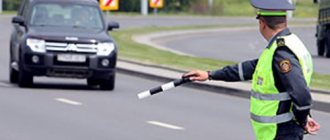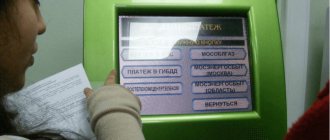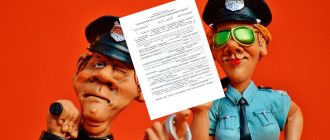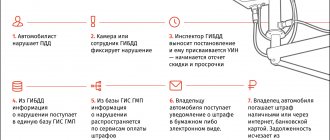Was a fine issued - according to the law or not?
The procedure for recording an offense is the main basis for issuing a fine. And if there was none, but nevertheless, the driver was issued a fine, he has every legal right to ask the question: “Is it legal for it to be imposed on him?” Let's give an example: the road along which a car is traveling is under video recording, but there is no sign indicating this anywhere. By the way, this incident happened in reality. Back in 2014, a car owner living in Tyumen won a court case for an illegal fine, citing the fact that the sign that was supposed to warn him and record video on the road section was not installed. Similar cases occur when a motorist drives into the oncoming lane. In 2007, for such behavior on the road, they were deprived of their license for six months, but since 2013, in addition to deprivation, they have also legalized a fine, which can reach 5,000 thousand rubles. Referring to such innovations, traffic police officers immediately began to pay close attention to such violations, and sometimes cross all boundaries, thereby violating the letter of the law.
Well, for example, the road is covered with snow in winter, and of course, it is impossible to see the markings, there is no sign on the road that would prohibit driving into the oncoming lane, and the driver does this. It is impossible to punish him for this, since the information was not conveyed to him that it was prohibited to drive towards him on this section of the road. And when explaining this fact to a traffic police officer, the driver, unfortunately, almost always remains guilty, since the patrol officers do not want to listen to him and simply issue a fine.
According to statistics, you can often find almost identical cars on the roads. They have the same brand, color and even somewhat similar numbers. And how offensive it becomes to a person when he, who has never violated any traffic rules, receives a fine, but a reckless driver in a similar car remains unpunished. Such situations occur because of those very video recording cameras that do not accurately identify the car and thus, because of them, decent drivers receive fines.
You can also often find that a fine for high speed and behavior violations near a pedestrian crossing is issued without any significant evidence. For example, equipment that records a vehicle speeding does not include photography or video recording. Then, the question immediately arises: “On what basis, where to apply, was a fine issued at all, if it is simply impossible to prove the fact that the road was not given way to the pedestrian?”
Rarely, but there are such road incidents that reach the point of absurdity. Back in 2021, a driver living in Moscow received a fine for driving into the oncoming lane. As it turned out later, after studying the photo attached to the fine, it was not the car itself that drove into oncoming traffic, but its shadow. The driver was so offended by this injustice that he went to court and challenged the issuance of a fine. As a result, the unjustified offense against him was dropped.
- Adhering to the law, the following reasons can be given that may serve to cancel the fine:
- The definition of the offense was incorrect.
- During the preparation of the protocol, certain norms were violated. These include the lack of witnesses, the lack of a certificate for the equipment on the basis of which a fine is issued, as well as obtaining evidence that is illegal.
- The statute of limitations has expired.
- The case of an administrative violation is being considered without the personal presence of the culprit, since he was not notified about it.
Description of the stages that must be completed to appeal the issuance of an illegal fine
Every vehicle owner has the right, established by law, to challenge the imposition of a fine. But, unfortunately, not everyone knows how to do this.
The driver can appeal against the illegal imposition of a fine in the manner prescribed by law, and it includes the following steps:
- An appeal against a fine is possible only within 10 days after the driver receives notification of his offense.
- Article 30 part 2 of the Code of Administrative Offenses gives each owner the right to apply to the authority he chooses:
- Direct appeal to the person who issued the fine. But, as a rule, such an appeal will be sent to a person with a higher position, so the next point is identical to this;
- Appeal to a higher official who is authorized to study these appeals;
- Appeal to judicial institutions (district or city) at the place where the decision was made.
As you can understand, the driver has several methods in his arsenal that will help him establish that he is right - to solve the problem in the traffic police, as they say, in a pre-trial manner, or to appeal a fine issued without legal grounds in the court itself.
IMPORTANT !!! In the event that while a traffic police officer is drawing up a protocol on the violation, the driver has every right to disagree with his arguments. For this reason, the protocol contains a column called “Explanation of the person”, in which the owner of the car can indicate his disagreement with the traffic inspector, for one reason or another. The employee filling out the protocol does not have the right to prohibit a person from filling out this column. It is illegal.
The majority of drivers, as statistics show, flatly refuse to sign the report on the offense drawn up by the road patrol officer. From the legal side, such behavior is illogical, because the inspector has every right to finish drawing up the protocol without the driver’s signature, inviting two people as witnesses. And, as a result, the driver’s categorical refusal to sign the document may turn against him if the case is considered by the court.
How to file a complaint with the traffic police that an illegal fine was issued
To help a person successfully challenge a fine, first of all, a correctly drafted complaint will help. All requirements that must be included in such a complaint are described in the Civil Code of the Russian Federation, namely in its Article 322.
ATTENTION !!! It is quite understandable that when preparing a complaint, a person is at the mercy of emotions, since he was accused of something that he did not commit. But, do not forget that a complaint is a document, and it is inappropriate to write an opinion about the inspector who compiled the protocol.
The complaint is drawn up in free form, but, nevertheless, if you are going to write it, you should adhere to a certain writing order:
- First, provide information about the person against whom the complaint is being written. Full initials and contact details are required.
- Next, indicate all information about yourself (the applicant), place of registration and contact information.
- Indicate the protocol number and the date on which it was drawn up.
- Write about asking to cancel the resolution.
- State the reasons why additional review of the protocol should occur.
- State the facts that prove that the applicant is right. This may include quite a lot of evidence, but, as a rule, it is video footage, photos, technical documents and more.
- Indicate the request: “Please consider it without my personal presence.” This must be done if the applicant cannot be present, so to speak, during the “showdown” of the case.
- Sign a document.
- Indicate the date on which the complaint is written.
After drawing up a written complaint, you can give it in person to the department, making sure that the employee has made a note of acceptance on it. Or, as an option, a ready-made complaint can be sent to the traffic police using mail services, and indicating that after delivering the letter to the addressee, it is necessary to provide the sender with a notification about this. Well, the last option is to send a complaint via the Internet using the traffic police website.
As mentioned above, the traffic police must consider the complaint within 10 days. This is stated in Article 30.5 of the Administrative Code. If, after the allotted time to study the complaint, the person is refused, he can go to court, which will make the final decision.
How to check and pay the debt for the Central Ring Road
There are two ways to check and pay off your debt:
On the official Avtodor website or in the mobile application
To check, you need to indicate the license plate number of the car and confirm your contact phone number. The site will show whether there is a debt on the car.
You can pay the debt using a bank card, a receipt will be sent by email
This method is suitable for individuals with one car, but is inconvenient for organizations. When checking several cars, the license plates of each will have to be entered manually
Through the Online traffic police service
This method is suitable for organizations that need to regularly check debt on several machines. It is enough to add all the cars in your fleet to your personal account once. The service will check:
- the presence and amount of debt for travel on the Central Ring Road;
- fines and enforcement proceedings for any violations, including violations of toll road rules.
Every day at 9 am, a report on travel arrears and fines will be sent to your email.
The organization will find out the number of violations and the total amount of debt and will be able to pay for travel from their personal account.
If you pay your fare on time, the organization:
- will not lose the discount if using a T-Pass transponder;
- eliminate the need to pay fines
Check fines for traveling on the Central Ring Road without paying
Do you want to monitor fines, receive a daily report on new fines found and pay them?
Try for free
Don't miss new useful publications
We will tell you about the intricacies of the legislation, help you understand it and tell you what to do in controversial situations.
Court and illegal fine
Before starting legal proceedings regarding the illegal imposition of a fine, it is necessary to determine which court to go to. The territorial jurisdiction of an institution can be determined using the Justice website. If the fine was issued by the inspectorate, then you should go to the first instance court (district, city or world). But, if the decision was made by the court, then you should go for an appeal to an even higher authority (for example, the regional one). The authority to which the complaint must be filed has been determined and the decision has been sent for consideration. Again, you can file a complaint only within 10 days after the driver has a copy of the decision in his hands. If during this period he does not have it, the driver has the full right to file a petition to renew the appeal period.
The court, unlike the traffic police, can consider a complaint not for 10 days, but for as long as 2 months. This difference in time is explained by the fact that the judicial authority must study all the evidence in detail and come to an objective verdict. But, as in any case, this also has its exceptions. Consideration of the application by the court can last only one day if the person who received the fine is also under arrest.
After examining the case, the court may come to the following decisions:
- The complaint is dismissed and the decision remains unchanged.
- Approve the complaint, remove the fine, and close the case.
- Cancel the fine and redirect the opened case for further consideration. This occurs if, while the court is studying the complaint and accompanying documents, new facts and circumstances arise.
What the courts said
The Magistrate's Court asked the post office for information about the delivery of the letter, but no one responded. The judge recognized the double fine as legal, based on the fact that MADI sent a copy of the decision on time.
The driver appealed to the district court, which again made a request by mail. The post office did not find documents confirming the return or delivery of the order. But the district court upheld the settlement's decision.
Let us help you appeal an illegal fine
Appeal
Law and abolition of the fine
The court can approve a driver’s complaint that a traffic police officer illegally issued him a fine only if:
- There is no human guilt.
- There are no actions that constitute grounds for a fine. For example, there is no record of a car driving towards you.
- The offense is described incorrectly, and it is replaced with a simple warning, and the fine is removed.
- There are facts that the person has already been prosecuted several times for this violation.
- There are grounds for releasing the person.
- There are no actions by the driver aimed at committing an offense.
- The statute of limitations has expired. Traffic police fines are valid for 2 months, and court fines are valid for 3 months.
Should traffic police fines be sent by mail?
3. In the event of an administrative offense provided for by Chapter 12 of this Code, or an administrative offense in the field of improvement of territory provided for by the law of a constituent entity of the Russian Federation, committed using a vehicle or by the owner or other holder of a land plot or other real estate object, recorded with the use of workers in automatic mode of special technical means having the functions of photography and filming, video recording, or means of photography and filming, video recording, or in case of confirmation in accordance with Part 2 of Article 2.6.1 of this Code contained in a message or application of the owner (possessor) of the vehicle information that at the time the administrative offense was recorded, the vehicle was in the possession or use of another person, a protocol on the administrative offense is not drawn up, and a decision on the administrative offense case is made without the participation of the person against whom the administrative offense case was initiated, and is drawn up in the manner prescribed by Article 29.10 of this Code. Copies of the resolution in a case of an administrative offense and materials obtained using automatic special technical means that have the functions of photography, filming, video recording, or means of photography, filming, video recording, are sent to the person against whom the case of an administrative offense has been initiated , by registered mail in the form of a copy of the resolution on paper , provided for in Part 7 of Article 29.10 of this Code, or in the form of an electronic document signed with an enhanced qualified electronic signature of an authorized official, using the Unified Portal of State and Municipal Services, taking into account the Rules for the provision of services by postal service within three days from the date of the said decision. The specified copy of the resolution in the form of an electronic document or the information contained in the resolution may also be sent to the person against whom a case of an administrative offense has been initiated, provided that such person is registered in the unified identification and authentication system and has the consent of such person to receive the information specified in this parts of the resolution or information using other means of information technology, including regional portals of state and municipal services, and (or) using mobile radiotelephone communications.
Why do erroneous fines occur?
In recent years, drivers have begun to complain that they are receiving so-called “lucky letters” in the mail, requiring them to pay a fine. And everything seems to be clear and understandable. But, while studying the letter, the driver realizes that this is not his car and he is not the offender, but that there was simply a mistake.
Why this might happen and why "happy letters" often go wrong:
- There is another car that has fake license plates that match the accused driver's license plate.
- The car is listed as stolen, and the person who committed it is violating traffic rules.
- A man sold his car, but information about the new owner has not yet been entered into the database, and therefore letters with fines are sent to the old owner.
- The equipment recording violations counted the license plate number of the accused driver, since she was driving immediately behind the car that had violated the traffic rules.
Such erroneous “happy letters” can also come because traffic police inspectors very often do not carefully draw up the puncture and do not fully understand the situation. Very often, one wrong number or letter can cause an innocent driver to receive fines that are not due to him. Also, in modern times, special equipment helps inspectors in catching offenders. After it detects a violation, all data enters the computer and there it processes it. Only then, all the information is received by the operator, who at a quick glance assesses the correctness of the robot’s actions, and, unfortunately, also sometimes makes mistakes. And because of such inattention, a whole chain arises leading to the appearance of erroneous fines. After all, after studying, the operator transfers the fact of violation into the hands of the inspector himself, who very often does not check all the information, but simply signs. After all, he is sure that the computer and the operator have already checked everything.
If there is no information in the traffic police database
Complaints on the topic “there is no fine on the traffic police website, but there is a resolution” are often found on Internet sites.
Citizens have doubts whether to pay the fine. Due to questions arising from motorists, the heads of the State Traffic Inspectorate commented on this problem. According to the official explanation, the reason lies in the very procedure of transferring information from one department to another. Traffic violations are recorded at the regional level. Employees of the territorial divisions of the traffic police draw up a resolution. After this, the information is transferred to the federal department, which records it in a common database. The next stage of information transfer is the Treasury. Its database stores information about all payment obligations of citizens. The multi-step process for transferring information may cause a delay in updating the shared database. Most often, this is the answer to the question why the fine is not in the traffic police database, despite the receipt received by mail.
Another reason for the lack of information about the traffic police resolution may be the use of various databases by the search system. According to practice, inspection services from regions have access to databases of regional traffic police departments. When requesting information through mobile applications, information is obtained from the Treasury database. On the traffic police website, data is checked from the federal system of the State Traffic Inspectorate. If a resolution is drawn up and entered into a regional database, it may not be in the federal system.
On State Services, the search is carried out based on information from the Treasury and the federal traffic police database. In this case, verification should be carried out in several ways. This approach guarantees a more detailed and reliable result about fines. The time for payment is 60 days. This makes it possible to periodically check data on new unpaid fines.
Read also: Checking accidents on the traffic police website How to challenge a parking fine in Moscow










